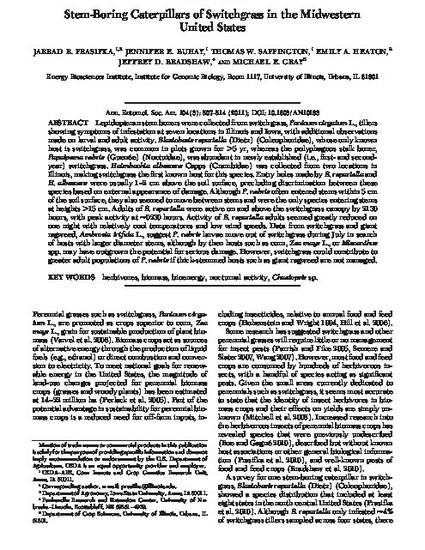
Lepidopteran stem borers were collected from switchgrass, Panicum virgatum L., tillers showing symptoms of infestation at seven locations in Illinois and Iowa, with additional observations made on larval and adult activity. Blastobasis repartella (Dietz) (Coleophoridae), whose only known host is switchgrass, was common in plots grown for >5 yr, whereas the polyphagous stalk borer, Papaipema nebris (Guenée) (Noctuidae), was abundant in newly established (i.e., first- and second-year) switchgrass. Haimbachia albescens Capps (Crambidae) was collected from two locations in Illinois, making switchgrass the first known host for this species. Entry holes made by B. repartella and H. albescens were usually 1‐2 cm above the soil surface, precluding discrimination between these species based on external appearance of damage. Although P. nebris often entered stems within 5 cm of the soil surface, they also seemed to move between stems and were the only species entering stems at heights >15 cm. Adults of B. repartella were active on and above the switchgrass canopy by 2130 hours, with peak activity at ≈0230 hours. Activity of B. repartella adults seemed greatly reduced on one night with relatively cool temperatures and low wind speeds. Data from switchgrass and giant ragweed, Ambrosia trifida L., suggest P. nebris larvae move out of switchgrass during July in search of hosts with larger diameter stems, although by then hosts such as corn, Zea mays L., or Miscanthus spp. may have outgrown the potential for serious damage. However, switchgrass could contribute to greater adult populations of P. nebris if thick-stemmed hosts such as giant ragweed are not managed.
Available at: http://works.bepress.com/emily-heaton/16/

This article is from Annals of the Entomological Society of America 104 (2011): 507, doi:10.1603/AN10183.